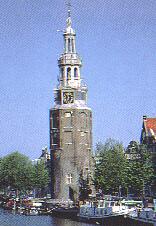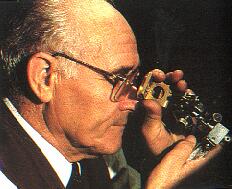Jewish area
Zuiderkerk
Montelbaanstoren
Diamonds history of Amsterdam
 Leave
the Nieuwmarkt by the St. Antoniebreestraat, off the southern corner and walk
briskly down this modern shopping street to turn right, via a narrow arched
gateway between nos.130 and 132 into ZUIDERKERKHOF. The Zuiderkerk (south
church), in the middle of this small square is landmarked by its graceful spire
and clock tower, embellished with red and gold dials. Designed in 1603 this
church is the first post-Reformation Protestant church, and its graceful spire
is claimed to have inspired Sir Christopher Wren, architect of St. Paul’s
cathedral and other historic London churches.
Leave
the Nieuwmarkt by the St. Antoniebreestraat, off the southern corner and walk
briskly down this modern shopping street to turn right, via a narrow arched
gateway between nos.130 and 132 into ZUIDERKERKHOF. The Zuiderkerk (south
church), in the middle of this small square is landmarked by its graceful spire
and clock tower, embellished with red and gold dials. Designed in 1603 this
church is the first post-Reformation Protestant church, and its graceful spire
is claimed to have inspired Sir Christopher Wren, architect of St. Paul’s
cathedral and other historic London churches.
Go back through the
Zuiderkerk gateway and turn right. At no.69 St. Antoniebreestraat, the De Pinto
house was built in Italian Renaissance style by Isaac da Pinto, head of a Jewish
dynasty who fled Spanish-ruled Antwerp in 1680. The building is now used as a
public library. Lovely painted ceiling, worth a quick look. Continue the
street’s opening onto the waterfront at St.Antoniesluis.
Your next outstanding
landmark is the Montelbaanstoren, built as a defensive tower in 1512 and
prettified a century later. This made is top-heavy, and it began to lean
precariously canalwards. The Amsterdammers, seeing no benefit in having a rival
to the Leaning Tower of Pisa, had it hauled upright again and reinforced its
foundations. Rembrandt, who lived not far away at the other end of the canal,
made a number of drawings and etchings of the tower, eland it was a rendezvous
for Jewish refugees from Spain and Portugal.
Get to the Nieuw
Uilenburgerstraat and walk it down to its southern end. On your left, just
before the junction with Uilenburgersteeg, is the Gassan diamonds factory. Built
in 1879 by the Boas family (who incidentally moved to Antwerp and I happen to
deal with their grandchildren in some diamond business), it is open to the
public, with daily tours and demonstrations of diamond cutting and polishing.
Unfortunately this is only show today, since the diamond industry, cutting,
brokering and all serious trade moved since WWII to Antwerp. But let’s have a
summary of the history of diamonds in Amsterdam.
Amsterdam became
Europe’s pre-eminent diamond broking and cutting center as a result of
combination of religious tolerance and intolerance. As we have seen, Jews
arriving from Spanish lands were not persecuted, and were permitted to worship
openly—the Great Synagogue, further along this walk is the oldest synagogue in
Western Europe—but they did suffer discrimination and were excluded from the
guilds and professions. Many of the Sephardic Jews who arrived in Amsterdam from
Spanish-held Antwerp in the early 17th century were diamond dealers with
Portuguese connections. They dealt in
raw diamonds, recruiting cutters and polishers from the Jewish community and
Jewish workers came to excel in this new skill. In the 19th century diamond
trade expanded into a fully industrialized process, team powered tools were
introduced in 1845 and the discovery of large diamond fields in South Africa in
1869 led to a boom. Amsterdam remained the world capital of the world until WWII
when most of the city’s Jew workers were deported and murdered by the German
occupiers. Ironically, it’s Antwerp that won back leadership of the world
diamond market it had lost 350 years earlier.
Cross the canal and
walk to the Jodenbreestraat, once the bustling heart of Jewish Amsterdam, and
turn right. Much of the Jodenbreestraat’s character has been destroyed over the
past decades, first by Nazi Holocaust and later by the demolition of its entire
north side to make way for the dull modern block, built in 1965, which now
occupies the site. A century ago the street was a colourful maze of slum
apartments and alleys where the poorest Jewish families lived, often ten to a
room.
Let’s face it: except
the house of Rembrandt we will visit in next article, nothing attracts our
interest in this street disfigured by sinister buildings.
Streaming powered by
Unreal Media Server
Back to
WebCamSue's Home Page
 Leave
the Nieuwmarkt by the St. Antoniebreestraat, off the southern corner and walk
briskly down this modern shopping street to turn right, via a narrow arched
gateway between nos.130 and 132 into ZUIDERKERKHOF. The Zuiderkerk (south
church), in the middle of this small square is landmarked by its graceful spire
and clock tower, embellished with red and gold dials. Designed in 1603 this
church is the first post-Reformation Protestant church, and its graceful spire
is claimed to have inspired Sir Christopher Wren, architect of St. Paul’s
cathedral and other historic London churches.
Leave
the Nieuwmarkt by the St. Antoniebreestraat, off the southern corner and walk
briskly down this modern shopping street to turn right, via a narrow arched
gateway between nos.130 and 132 into ZUIDERKERKHOF. The Zuiderkerk (south
church), in the middle of this small square is landmarked by its graceful spire
and clock tower, embellished with red and gold dials. Designed in 1603 this
church is the first post-Reformation Protestant church, and its graceful spire
is claimed to have inspired Sir Christopher Wren, architect of St. Paul’s
cathedral and other historic London churches.